|
Read this excellent article by Anton Takken from Kennedy Electrics Inc:
Request for information What you should consider when you are unsure of the architect's intentions in their bid document.
0 Comments
"Whenever a construction project goes wrong the blame is often put to bad luck. Construction Project Managers and contractors in general must be some of the most optimistic people on earth. It won’t rain during the construction project, construction materials will arrive on time, equipment won’t break down, our teams will produce the production expected of them for the full duration of their shift, construction drawings will arrive timeously, subcontractors will produce their part of the construction project on time, and so it goes on. Indeed I think only farmers could be a more optimistic bunch, depending almost entirely on the vagaries of the weather and believing it will rain at the right time, never too little or too much. Certainly whenever a construction project goes wrong the blame is often put to bad luck. If only we hadn’t had that storm just then, if only the subcontractor had delivered what they promised, if only the client had been more accommodating, why did the workers have to walk off the project, with just a little luck we could have finished the construction project on time and made the millions we thought we would. "Yet some problems on construction projects could have been foreseen." Yet some of these problems could have been foreseen, and either avoided or mitigated. So how can we take control of our construction projects, leaving less to luck and chance, and engineer our project’s successful destiny? #constructionproblems #constructionmanagement #contractors Avoiding problems on construction projects Image by Maciej Cieslak from Pixabay Image by Maciej Cieslak from Pixabay The more we plan the luckier we get A good golfer said the more he practiced the luckier he got. Well in construction the more we plan the luckier we get. Thinking through our method of construction, allowing for access, selecting the best subcontractors, preparing a suitable construction schedule (programme), arranging the appropriate resources and timeously ordering the correct construction materials will all help prevent crises later in the project. How many construction projects are disrupted by the weather, yet, some of the problems could have been foreseen and avoided by completing weather dependent tasks ahead of the rainy, windy or cold seasons? Good planning can, and will help you avoid many problems, making you lucky, and your construction project successful. "Preventing a fire is often much easier than extinguishing a blazing inferno." Are you a firefighter or a fire prevention officer? I have worked with Construction Project Managers who could literally solve any problem. In fact, to be with them was exhausting, as they were continually solving problems – phone glued to their ears as they frantically made calls; cajoling, begging and persuading suppliers, contractors and Supervisors to urgently deliver missing material, complete a task or get more resources onto the project. Why were they faced with these multiple emergencies – well someone hadn’t ordered materials, the construction schedule was slipping, there were insufficient resources, etc, etc. Why had this happened, well because the Project Manager was so busy solving problems that they had forgotten, or simply run out of time! Yet, I’ve been on other well managed construction sites where it seemed that the Project Manager was hardly doing anything – no shouting, no frantic phone calls. Everything seemed to be running like clockwork. Preventing a problem from arising on a construction project often takes much less time than solving the problem should it arise. Preventing a fire is often much easier than extinguishing a blazing inferno. Employ the right team Most construction projects are built by a team. Selecting the right team for your project is essential. It doesn’t have to be the best team – because even good people often have failings, and may not be right for a particular project, client or team. You need people you can depend on to deliver a quality project on time and safely. #constructionpeople #constructionprofessionals "Even the best people need direction." Direct your team But even with the right people you still need to give them direction. They need to know what their responsibilities are, and what their limits of authority are. They need to understand the construction project requirements, the construction schedule and specifications are. You need to delegate, but also monitor what they are doing. One small task missed or left undone can lead to untold problems. Think of that long lead item not ordered or reinforcing that wasn’t checked before concreting which could spell disaster. Understand your team The few construction projects I had go wrong were when I was working with a new team. I didn’t understand their weaknesses and depended on them to complete a task or manage the construction project only to later find they weren’t capable, or didn’t have the knowledge. By using the strengths of your team and supporting their weaknesses, teaching and mentoring them where necessary, it will be possible to prevent mistakes happening. Forewarned is forearmed It’s important to keep your ear to the ground, talk to those who have local knowledge, read the newspapers, and talk to your crew. Locals may have a better understanding of the local weather patterns, flood lines, traffic, existing services and local conditions. They may provide valuable contacts, inside to the local politics, what to do and what you shouldn’t do. Keeping up with the news could give forewarnings of clients, contractors or suppliers facing financial problems. It’s amazing what your crew sees and knows and they often have the lowdown on potential trouble long before you. Of course don’t believe everything you read and hear, and do your own investigation before accepting it’s true. Understand the risks Unfortunately many contractors start a construction project without fully understanding the risks. By understanding the risks you can take preventative actions which can either prevent the risk from eventuating, or if it does ensure that the extent is mitigated so the project isn’t overwhelmed. It’s good practice to prepare a risk schedule when you price the project, update this before you start and then monitor and update the schedule as the construction project progresses. Of course ensure your team is also aware of the risks and understand what actions need to be taken to mitigate the potential risks. Risks must be managed. Collect the correct data and use it wisely Data is king – but only if it is correct and is used wisely. I have worked for contractors that have produced monthly reports of a hundred pages, yet some of the data was suspect, some was fudged to present the best result to management and much of it was ignored or misinterpreted. There is much valuable data that can be collected on construction projects, starting with a correctly updated construction schedule. But often the schedule isn’t correct in the first place, if it is it’s not updated correctly, and if it is sometimes the update is ignored or the wrong actions are taken to correct slippage. Collect the right data, ensure it is accurate and current, and then interpret it correctly using it to catch problems timeously and take remedial action. "Don't be so focussed on the details that you miss the train about to run you over. But also don't trip over a missing detail." Keep an eye on the big picture but don’t forget the details Some Construction Project Managers slip on the details, only focussing on the big picture. Details are important and it’s often the tiniest details overlooked which result in mega problems. Then there are some Project Managers who are so focussed on the details that they fail to see the train that’s about to run them down. Ask questions When in doubt ask a question. If the information isn’t clear seek clarity. Too many mistakes are made because we assumed something or misunderstood the information. Questions also act as reminders to others ensuring that tasks don’t get forgotten or slip through the cracks. I probably irritated my teams by always asking if they had completed a task, ordered an item or taken note of a potential problem. Better a little irritation than a delay caused by a missed task. "Small actions can often save a great deal of pain." Sometimes small actions can save you future problems We all take shortcuts at some stage, some can save valuable time and costs, but many are just laziness on our part and haven’t been well thought through. Small actions can often save us a great deal of pain – think of creating a berm around excavations to keep stormwater out, keeping stormwater drains clean, providing sufficient lighting, ensuring the worksite has safe access or stopping an unsafe act can all appear an inconvenience or cost, but often the minor extra cost and inconvenience will be far less than the costs of a flooded worksite or an accident. Check, check and check again The saying goes measure twice and cut once. How often have we all been tripped up by errors; where buildings have been set out incorrectly, materials have been under ordered or over ordered and items have been fabricated to the wrong size or specification. Spend a little extra time to ensure what you have ordered or measured is correct. You can avoid many potential problems on your construction projectUnfortunately problems will and do occur in construction and I will discuss pre-empting and dealing with these in a future article. However, with good planning, the right team and sound project management skills many of these problems can be avoided. View similar articles by the Author – visit the index of construction articles on this website This article is adapted from the author's books. To read more about these books and find out where you can purchase them visit the pages on this website by clicking the links below: 'Successful Construction Project Management: The Practical Guide' 'Building a Successful Construction Company: The Practical Guide' "I highly recommend this book be read by all newly qualified construction project managers as well as those more experienced." (Reader 1 - Amazon.co.uk) Paul Netscher has written several easy to read books for owners, contractors, construction managers, construction supervisors and foremen. They cover all aspects of construction management and are filled with tips and insights.
Visit to read more. The books are available in paper and ebook from most online stores including Amazon. © 2015 This article is not to be reproduced for commercial purposes without written permission from the author. "Material handling can play a major role on some projects often resulting in a bottleneck if it’s not planned correctly." Material handling can play a major role on some projects often resulting in a bottleneck if it’s not planned correctly. The project may have the right numbers of personnel and equipment, but if the materials can’t get to where they are required, then personnel and equipment will be unproductive and the project will be delayed. Material management is not only a planning issue, but can also be one of diplomacy, since the Project Manager and Supervisors must juggle the needs of the different teams on the project. Often the various teams and subcontractors can become irate and frustrated due to delays in receiving their materials. Material handling can be a particular problem on high-rise buildings where items and personnel, including those belonging to subcontractors, must be delivered to elevated locations. Materials which aren't handled correctly can become damaged, resulting in quality problems and extra costs. The damaged materials also have to be replaced which could cause delays. On some projects the breakages can be enormous resulting in further costs to remove the broken product. Sometimes when materials aren't handled correctly they can cause safety hazards and I'm sure we have all at some stage witnessed loads breaking free from cranes or slipping off trucks. Often this results in serious injury as well as damage to property. Like this accident or these steel bars that were dropped Of course it is also important to ensure materials aren't contaminated while they are being handled. This may occur when trucks or machine buckets aren't cleaned out properly between different products or when the material is left unprotected or placed directly on the ground or in the mud. Handling construction materials efficiently"Project Manager and Supervisors must juggle the needs of the different teams on the project. " What can we do? To help handle materials efficiently: 1. ensure there are sufficient people and the right type of equipment to handle them 2. make sure material transport, loading and unloading is organised and managed properly Daily planning of construction projects 3. look at ways to assist with loading and offloading, such as getting the supplier to pack and secure the items onto pallets (there may be an additional cost, but it will save time and make handling easier once the item arrives on site) 4. it may be necessary for deliveries to take place after-hours when cranes will be available 5. offload material close to where it is required 6. ensure storage areas are well-planned, organised, neat, with a traffic management system and good access roads 7. plan the project at the start to ensure there will be sufficient cranes and access 8. sometimes just adding an extra operator can mean that the crane can work through lunch hours and longer hours 9. supervisors need to understand the lifting priorities and not hold onto a crane longer than needed 10. think out the box sometimes - many in construction become totally fixated on a crane when there are often other ways of doing the task without a crane, or maybe even pre-assembling sections on the ground and lifting it in one piece #constructionmanagementtips #constructioncranes #constructionproductivity Efficient handling of construction materials has real benefitsDon't let poor planning and management of the moving and lifting of construction materials cause your to suffer delays and frustrations. If there are delays on your project investigate their reasons and you may well find that personnel are waiting for materials which are slowing down their production. Employing additional resources may be a small additional cost which could save you far more in the long run. Remember no one wants to be waiting for materials. They want them close at hand when they need them, and they certainly don't want them damaged in transit. How to improve construction productivity #constructionmaterials #constructionmanagement #constructionprojectmanagement View similar articles by the Author – visit the index of construction articles on this website "The tips included in this book are arranged and structured in a very good way. Very useful book for construction practitioners." (Reader Amazon.com) This article is adapted from the author's books. To read more about these books and find out where you can purchase them visit the pages on this website by clicking the links below:
'Successful Construction Project Management: The Practical Guide' 'Building a Successful Construction Company: The Practical Guide' 'Construction Book reviews' To read more about the author visit the page 'Paul Netscher' Want to contact Paul Netscher please enter your details on 'Contacts' © 2022 This article is not to be reproduced for commercial purposes without written permission from the author. What could be simpler, a drawing is issued to the contractor, the contractor orders materials which are delivered to the project site and the contractor installs them? Yes, it should be simple, but in many cases the process goes wrong, resulting in wasted time, delays to the project, additional costs, and upsets in the relationship with the client. When ordering materials it’s obvious that the correct quantity should be ordered. Sounds easy, but often projects run short of material which results in problems. planning deliveries to construction sites #constructionmaterials #constructionmanagement Problems when a project runs short of construction materialsIf a construction project runs short of a particular item or material it usually creates problems which have both time and cost implications for the project. These include: · if the material is imported it may have to be air-freighted at short notice and enormous cost · the material may not be readily available and take several weeks for the supplier to manufacture the required items · the material may be no longer manufactured (as may be the case with ceramic tiles), and if the contractor is unable to locate material to match those already installed, they may have to rip these out and replace them with other available material · ordering small quantities often adds a premium to the procurement and transport · even if the material is readily available, off-the-shelf from a supplier close to the project, there will be the cost for the contractor’s personnel making a special trip to collect it · sometimes the materials are being installed by a specialist contractor who is now unable to complete their works, which may then cause them to demobilise from site, resulting in additional costs and possible further delays if they can’t return immediately due to their other commitments · shortages disrupt the work since workers employed with the task have to be redeployed to another part of the project, returning only when the correct materials are available · the procurement of the additional materials and organising their transport absorbs a large amount of additional management time · the delay caused to the project by the shortage of materials makes the contractor appear disorganised and unprofessional "So why do projects frequently experience shortages of materials?" Reasons construction projects run short of material · Often it’s simply caused by the Project Manager, Engineer, or Supervisor incorrectly measuring the quantity from the drawing. · Sometimes the Designer or Architect has included the quantity on the drawings but they are incorrect and the contractor orders the quantities from this without checking. It’s therefore good practice for contractors to check the quantities provided on a drawing, since if it’s wrong they could be liable for the error. · No allowance is made for wastage of the material. Items like ceramic tiles or building blocks will generate wastage due to cutting and breakages. An experienced contractor will know what this wastage will be, which often depends on the actual details of where the product is used. Small areas may require detail cutting, which will generate more waste than large, simple areas. Electrical cables are another example since it may not be possible to use the full length of cable because the project specifications or regulations, will not allow the cable to be spliced, leaving all the short bits of cable to be wasted. · The incorrect conversion factor is used, which often occurs with earthworks materials when the incorrect factor is used for converting the loose material into compacted material. (This factor depends on the type of material and the amount of compaction required.) When material with unfamiliar properties and characteristics is ordered it pays to seek expert advice regarding what wastage or compaction factors should be allowed. · No allowance is made to lap the material. This is particularly the case with mesh reinforcing, plastic sheeting or roof sheeting. To minimise wastage due to lapping, or splicing of the materials, it’s important to be aware of the standard sizes the material is supplied in. In some cases it may be possible to order materials in different widths and lengths, reducing the number of joints and therefore the amount of lapping. · Sometimes there is theft on the project, so critical material should always be stored in secure locations. · Often the material has been incorrectly applied on the project. For instance the product has been applied in thicker layers than those specified, this may happen with paint, asphalt, concrete, joint sealer and adhesives. The Project Manager should monitor the application of specialist products, or products that are used in a large quantity on the project. This will enable timely action to be taken to reduce the thickness and wastage, and if necessary to order more material to make up any shortfall. · The incorrect quantity could have been delivered. I’ve seen it happen that a project ran out of a material, the Project Manager contacted the supplier and arranged for additional material to be delivered. Shortly thereafter the remaining material from the original order arrived followed by the additional material requested. This results in excess material remaining at the end of the project and causes wasted effort and cost. It’s good practice when an unexpected shortfall occurs, that the reason behind it be investigated before ordering the additional material. But what happens when there’s a surplus of construction materials on the project? "Why are there often surplus materials left at the end of many projects?" The cost of excess construction materials"The cost of excess material is more than just the original purchase cost" Of course, the opposite can happen too, with a surplus of material left at the end of the project. Almost every project I’ve been involved with has ended up with materials left over. This is a waste of money because: · the contractor has purchased material which is not required, although sometimes the material can be returned to the supplier for credit, it’s seldom they will refund the full original cost even if the material hasn’t been damaged while in storage or transit, and is still in its original packaging · there are costs of transporting, offloading and storing the surplus materials · there are the additional costs to transport and dispose of the surplus material (disposing of the material can be a significant cost which may include tip fees, and, with some chemicals, additional hazardous waste disposal fees) Reasons why surplus construction material remain at the end of projectsThe reasons for having surplus material are: · similar to the reasons that result in there being a shortage of material · the client may have changed drawings omitting items after the contractor had already procured them · the contractor may have accidently omitted the item from the structure · that it may have been applied in thinner layers than specified · that it may have been mixed incorrectly It would be pertinent to investigate the cause of the surplus material since some of the above reasons could have serious consequences for the contractor. When ordering bulk materials like fuel, cement, concrete aggregates or road materials, nearing the completion of the project it’s prudent to carefully plan deliveries, ensuring there is only a minimal amount of unused material left on the project. Take care when ordering construction materialsIt’s worth spending extra time to ensure you order the correct quantities of materials. Where necessary ask for expert advice to determine the normal wastage factors. This could avoid costly and embarrassing mistakes. Do Your Material Deliveries Suck? How to avoid problems #constructionmanagementtips #constructionprojectmanagement View similar articles by the Author – visit the index of construction articles on this website This article is adapted from the author's books. To read more about these books and find out where you can purchase them visit the pages on this website by clicking the links below:
'Successful Construction Project Management: The Practical Guide' 'Building a Successful Construction Company: The Practical Guide' 'Construction Book reviews' To read more about the author visit the page 'Paul Netscher' Want to contact Paul Netscher please enter your details on 'Contacts' © 2022 This article is not to be reproduced for commercial purposes without written permission from the author. "Construction companies are always searching for their next project." As construction companies we are always searching for new projects to bid on. We examine bidding lists, visit potential clients, and even advertise. But an important source of new projects is our existing clients. Our existing clients not only could have further projects for us to bid on, but they also often recommend our company to other potential clients. I know, even with our maintenance and renovation projects at home we often ask friends and neighbours who they would recommend. Also, in our construction division we often constructed more than one project for our clients, and in some cases went on to complete 5 phases of projects. "Many contractors forget how important it is to keep a good client." Yet many contractors seem to forget how important it is to maintain good client relations. In fact in this day and age of instant messaging it is even more important. The wrong tweet or Facebook post by an irritated customer can almost instantaneously destroy a small business that has taken years to build. In fact, some of the reviews posted on accommodation websites or Amazon and ebay can be quite vindictive, often going far beyond what the issue deserved. Unfortunately some people can become unnecessarily malicious. It’s therefore important to bare this in mind, and ensure that your staff understand how important customer service is. What is good service in construction?So what is good customer service in the construction industry? Clients generally expect : · A quality project. · A project that meets their requirements. · A project delivered with the minimum of fuss and inconvenience to them. · A contractor that provides fast and efficient service when there are problems. · A fair price – although unfortunately there will always be some expecting something for nothing – but then it’s probably best to stay away from these clients because there’s no making them happy. · A project delivered on time and when the contractor said it would be completed. · Honesty and integrity. · Professionalism. Many of these are known before we start a project and can be measured in the course of the project. We understand the quality requirements and the schedule and we can, and do deliver on them. The problem arises when the client or owner has different expectations to ours. This is sometimes because the scope and contract document aren’t clear. But, sometimes it is because the client doesn’t understand their own document. It is important that both you and the client have the same expectations, because even if you deliver the project in accordance with the document and you are contractually correct, an unhappy client can do damage to your reputation. A fair price is always difficult particularly when it comes to variations and extras. Sometimes the best is to try and avoid variations and ensure the client doesn’t delay the project in anyway and that changes are kept to the minimum. When there are variations the client needs to be made aware of them as soon as possible. Pricing of the variations should be fair and explained to the client. Making an extra few hundred dollars from a variation can seem a good idea at the time, but an aggrieved client might not consider your company for their next project which could be worth lots more money than the few dollars you made on the variation. "Keeping a good client takes work" You cannot assume your existing customers will come back to you or recommend your company to friends and other companies. It takes lots of effort to keep working at the relationship and keep meeting their expectations. Sometimes it’s better to hear complaints from your client when you visit them, since at least they are talking to you and you can rectify the problem or explain why something happened as it did. It’s when your client isn’t talking to you that you should be worried. That’s when they have probably given up on your company and it’s too late to rectify the situation. Some contractors do their reputation harm when they underbid a project just to get it, and then don’t have the correct resources to deliver the quality project the client expects, or they try and make up shortfalls in their price by submitting numerous inflated claims and variations. Contractors must look after good clientsIt’s easy to dismiss a client’s complains as just another complaining client. But you do so at your peril. Don’t underestimate at how much damage an employee can do to a company’s reputation. Either by being rude, greedy, unhelpful or performing their job badly. Employees must understand the vital part they play in maintaining the company’s reputation and how this could impact whether you get your next project. Do you want to learn how to manage construction projects successfullyThis article is adapted from the author's books. To read more about these books and find out where you can purchase them visit the pages on this website by clicking the links below:
'Successful Construction Project Management: The Practical Guide' 'Building a Successful Construction Company: The Practical Guide' 'Construction Book reviews' To read more about the author visit the page 'Paul Netscher' Want to contact Paul Netscher please enter your details on 'Contacts' © 2015 This article is not to be reproduced for commercial purposes without written permission from the author. "clients often joke that if they don’t know where the underground services are they should call a contractor in, and they’ll quickly dig them up." Existing services such as electrical cables, gas mains, water lines and telecommunication cables are often damaged when excavations are being carried out on construction projects. In fact clients often joke that if they don’t know where the underground services are they should call a contractor in, and they’ll quickly dig them up. Of course this isn’t so funny for the contractor, especially if they damage a fibre optic cable which costs thousands of dollars to repair. "Accidently breaking a utility line can be dangerous, expensive, and disrupts work" The cost of damaging an existing serviceContractors definitely don’t want to damage existing services on their construction projects because: 1. the repair costs can be large 2. when a high voltage electrical cable is damaged there’s a risk someone will be electrocuted 3. work is often held up until the repair is completed, which may take several days 4. often a cable is unknowingly damaged, but remains operational, and only later, after the contractor has installed concrete floors and finishes the cable fails, resulting in the completed work having to be broken up to repair the fault 5. if an electrical cable feeding the site is damaged it could mean the site is without power for several hours or days, impacting the schedule and productivity 6. the client and neighbouring businesses will be unhappy if the contractor disrupts their services (even claiming for losses incurred) #constructionmanagement How contractors can avoid damaging existing services"Contractors must obtain the necessary permits before excavating" It’s important that you: 1. obtain all the necessary permits before excavating, drilling, cutting into, or demolishing structures 2. ensure all the known services are located 3. clearly mark these services (I cannot tell you how many times we’ve damaged known services because they weren’t marked) 4. protect the services where possible 5. ensure all newly installed services are clearly marked on the ground and on drawings 6. ensure workers are aware of the services and take precautions not to damage them 7. clearly highlight the risk of damaging the services in risk assessments and at prestart meetings 8. use personnel that are adequately trained and competent, so they don’t accidently operate a machine in a way that damages a service #constructionsafety #constructionpermits "Overhead power cables are dangerous" Damage to services applies to overhead ones as well, and you must take steps to ensure that construction machines don’t come close to overhead power lines or structures, as this could result in a fatal accident. Like this fatal crane accident Contractors must protect existing utility linesDamaging an existing service can be costly, disruptive and often dangerous. The project team needs to be made aware of all existing services and ensure that suitable precautions are taken so they aren’t damaged. 10 Commandments for Construction Project Managers #constructionmanagementtips #contractors #constructionprojectmanagement For other articles on this website which might interest you visit the index of construction articles. 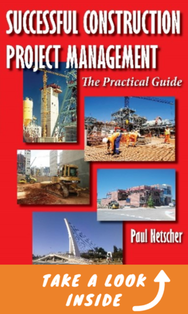 This article is adapted from the author's books. To read more about these books and find out where you can purchase them visit the pages on this website by clicking the links below: 'Successful Construction Project Management: The Practical Guide' 'Building a Successful Construction Company: The Practical Guide' © 2022 This article is not to be reproduced for commercial purposes without written permission from the author. "It is a very easy to use book with guidelines that are referenced intelligently with case studies." (Reader Amazon.com) What benefits does being environmentally friendly bring to your construction project? Tell most contractors they should make their construction projects more environmentally friendly and they will probably think only of extra costs, and reason scornfully you must belong to some green movement. However, there are benefits to being environmentally friendly and these benefits are more than just saving the planet. How to make construction projects environmentally friendlyWhat do you consider key to making your project environmentally friendly? Well most will trot out the same old answers; separate waste, pick up rubbish, don’t spill fuel and oil, and don’t damage the trees, but there is more to consider. 1. Reduce the amount of waste on your project. 2. Recycle waste. 3. Control storm water run-off preventing soil erosion and controlling silt deposition 4. Clean-up fuel and oil spills 5. Minimise the clearing of vegetation. 6. Prevent dust. 7. Reduce energy usage. 8. Don’t waste water. 9. Reduce the amount of noise "Much of this is just about sensible contracting." What are the downsides of not being environmentally friendly? The cost of poor environmental practices on your construction project1. Reputation – a fast way of receiving negative media attention is by having an environmental accident on your project, or damaging vegetation or animals, or creating excessive dust or noise that irritates neighbours and the general public. 2. Fines – Environmental agencies are gaining more teeth, which in some cases enable them to fine contractors for environmental damage, and even close down project sites that don’t comply. Like this construction project 3. Extra costs – although most regard being environmentally friendly as being a costly exercise, the cost of not considering the environment is large. a. Energy inefficient equipment costs more to run b. Disposing of waste is becoming more costly. There are the dump fees, plus the cost of loading and hauling the waste. Reducing waste has to save money. Recycling helps reduce waste. c. Water is expensive and a scarce resource in most areas. Reducing the amount of water construction uses must save money. d. Clearing excessive vegetation generates waste, in addition it leads to soil erosion, resulting in additional costs to clear storm water drains, rebuild up the eroded area and revegetation costs. 4. Poor client relations – Well no client wants the poor publicity that an environmental incident brings, or unhappy neighbours complaining about environmental infringements. In fact most clients have to comply with an environmental management plan and infringements could result in fines or work stoppages. Furthermore many clients are becoming more environmentally responsible and are now demanding the same of their contractors. You want to continue to work for these clients in the future so you need to prove that you are environmentally responsible as well. 5. Poor public perception – Poor environmental controls often result in untidy sites. It gives the impression that the contractor cannot manage the project. Dare I say it gives the impression the contractor doesn’t care. Would you want a contractor who doesn’t care building your project? Some clients and some projects demand a contractor that has clearly demonstrated they care about the environment. #constructionmanagement #constructionprofessionals #constructionindustry "Being environmentally friendly doesn’t have to be hard work or expensive. It often takes only a little extra care and effort" Easy environmental wins in constructionBeing environmentally friendly doesn’t have to be hard work or expensive. It often takes only a little extra care and effort and education of the workforce. Here are a few suggestions that will not only make your construction project more environmentally friendly, but will also save your project money. 1. Reduce the amount of rework. Rectifying poor quality costs money and creates waste. 2. Separate and recycle waste. Some recycled materials can be used for fill on the project reducing the amount of material that must be imported. 3. Control and reduce stormwater run-off. Stormwater can flood the works, erode under foundations, fill drains with silt and even wash away structures. 4. Select the right type and size of equipment for the task and choose equipment that is fuel efficient, doesn’t leak oil, isn’t smoky and creates the least noise. In other words avoid using older equipment, which anyway is normally less reliable and will cost you more to run. 5. Order the correct quantity of materials in amounts or sizes which will generate the least amount of waste or off-cuts. Do Your Material Deliveries Suck? How to avoid problems 6. Ensure materials are installed correctly with the minimum amount of cutting and waste. 7. Reduce the amount of breakages of material in transit and on site. This may be by better packaging or improved material handling systems. Handling construction materials 8. Educate employees on the cost of waste to the project. 9. Clearly demarcate areas of vegetation that don’t need to be (or shouldn’t) be cleared. (I had one project where the fence contractor used a massive bulldozer to clear a 4m wide strip of vegetation so he could install the cattle fence on the boundary – the client wasn’t very impressed to say the least.) Being environmentally friendly will save your construction project moneyMake your construction projects more environmentally friendly. It often doesn’t take much extra effort and you may be surprised at the money it saves you and the new opportunities it could bring. Oh, and of course you do your bit to save the planet at the same time. This project aims to have zero waste #constructionwaste #greenconstruction #constructionindustry Other articles by the author: Increase profits – reduce material wastage on your projects Planning deliveries to construction sites Understanding what impacts your company’s reputation "A MUST Read for any Construction Professional to raise their game!" (Reader Amazon Canada (Written by Paul Netscher the author of the acclaimed books ‘Successful Construction Project Management: The Practical Guide’ and ‘Building a Successful Construction Company: The Practical Guide’. Both books are available in paperback and e-book from Amazon and other retail outlets. This article is adapted from information included in these books.)
© 2022 This article is not to be reproduced for commercial purposes without written permission from the author. |
Archives
June 2024
Note: We welcome genuine comments, especially comments that add additional information to the subject matter in the article. We however reserve the right to remove inappropriate comments, which includes comments that have nothing to do with the subject, comments that include inappropriate language, and comments that are an advertisement for a product or company, or which include an advertising link. Comments must be in English. We will not enter into discussion on why a particular comment was removed.
CategoriesCopyright 2016 - The attached articles cannot be reproduced for commercial purposes without the consent of the author.
The opinions expressed in the attached articles are those of the writer. It should be noted that projects are varied and different laws and restrictions apply which depend on the location of the contractor and the project. It's important that the reader uses the supplied information taking cognisance of their particular circumstances. The writer assumes no responsibility or liability for any loss of any kind arising from the reader using the information or advice contained herein. "I have what I consider some of the best books on construction management."
Books are available from: Amazon.com Amazon.co.uk takealot.com kalahari.com Amazon.in Amazon.de Amazon.fr Amazon.it Amazon.com.au Powell's Fishpond uread bokus Amazon.ca Amazon.es Other retail stores Available in paperback or on Kindle "28 YEARS OF CONSTRUCTION PROJECT MANAGEMENT EXPERIENCE, DEVELOPING SUCCESSFUL CONSTRUCTION PROJECT MANAGERS AND BUILDING SUCCESSFUL CONSTRUCTION COMPANIES"
|


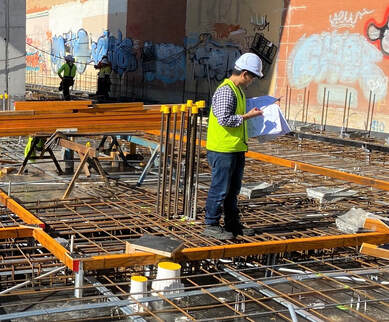
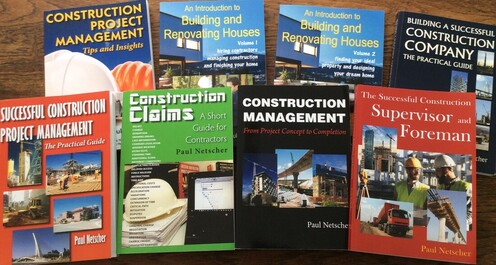

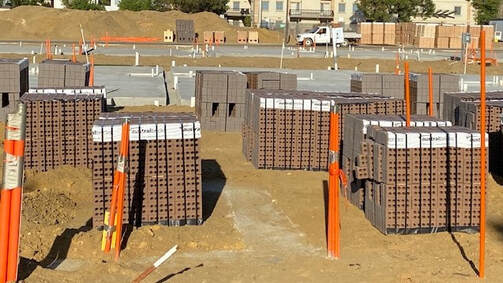

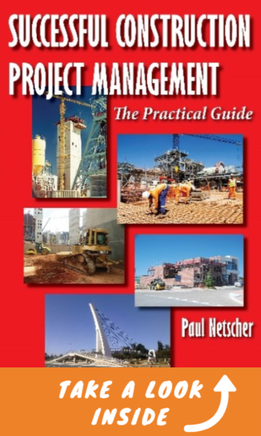
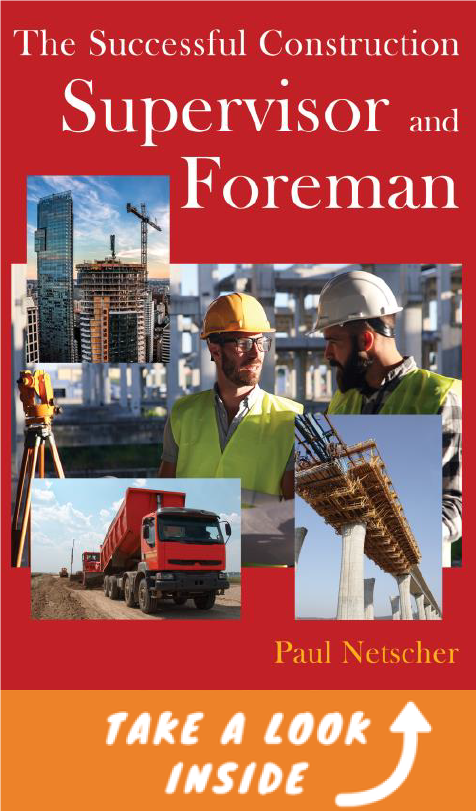
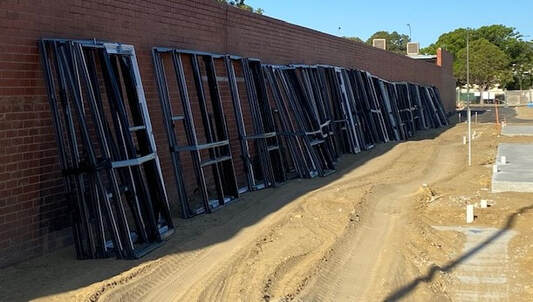

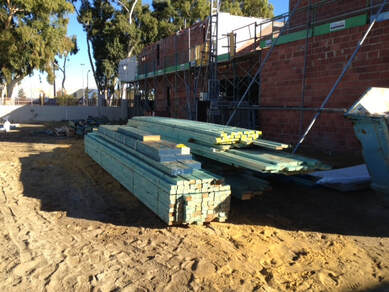


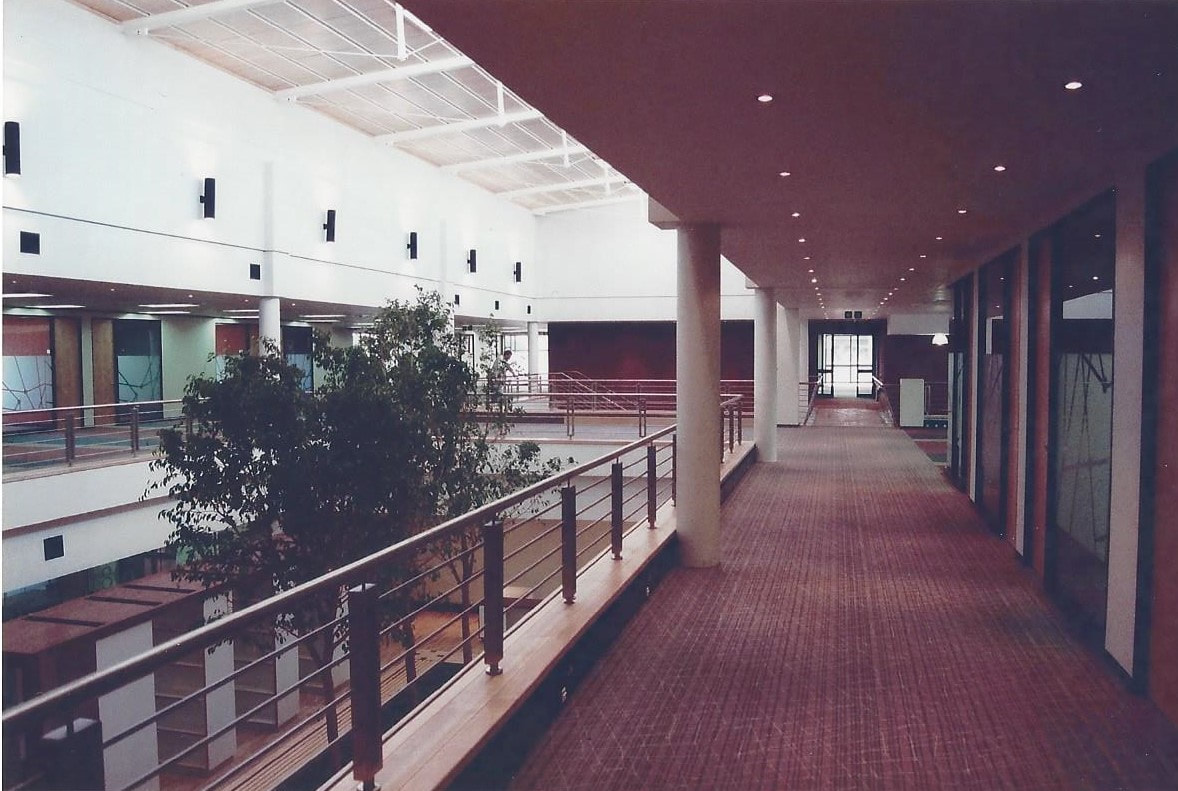

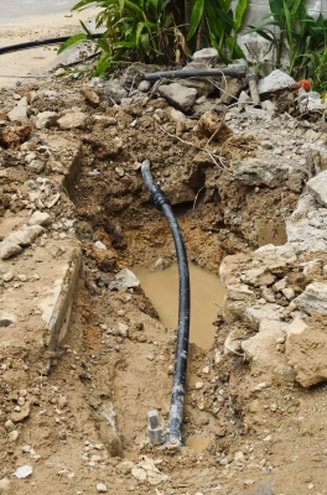

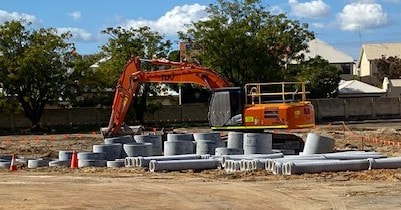
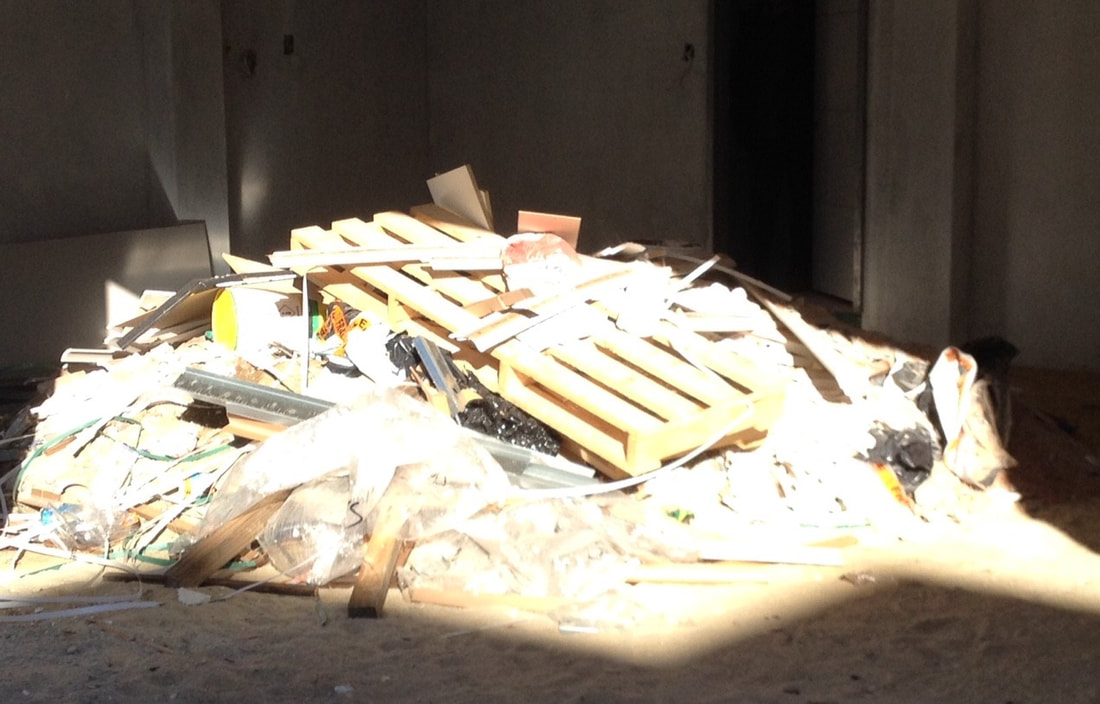
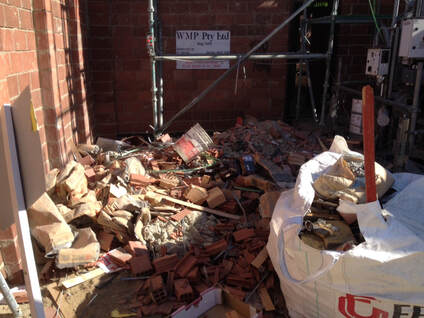

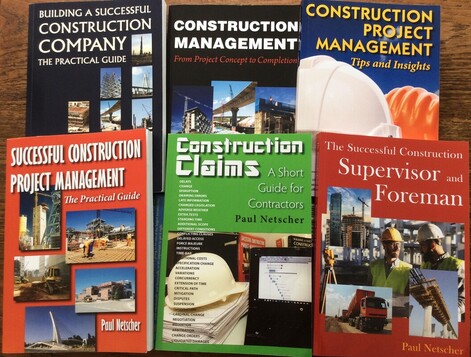


 RSS Feed
RSS Feed




